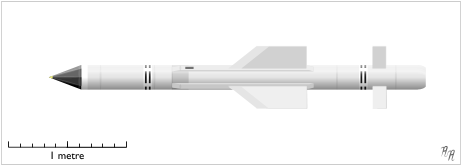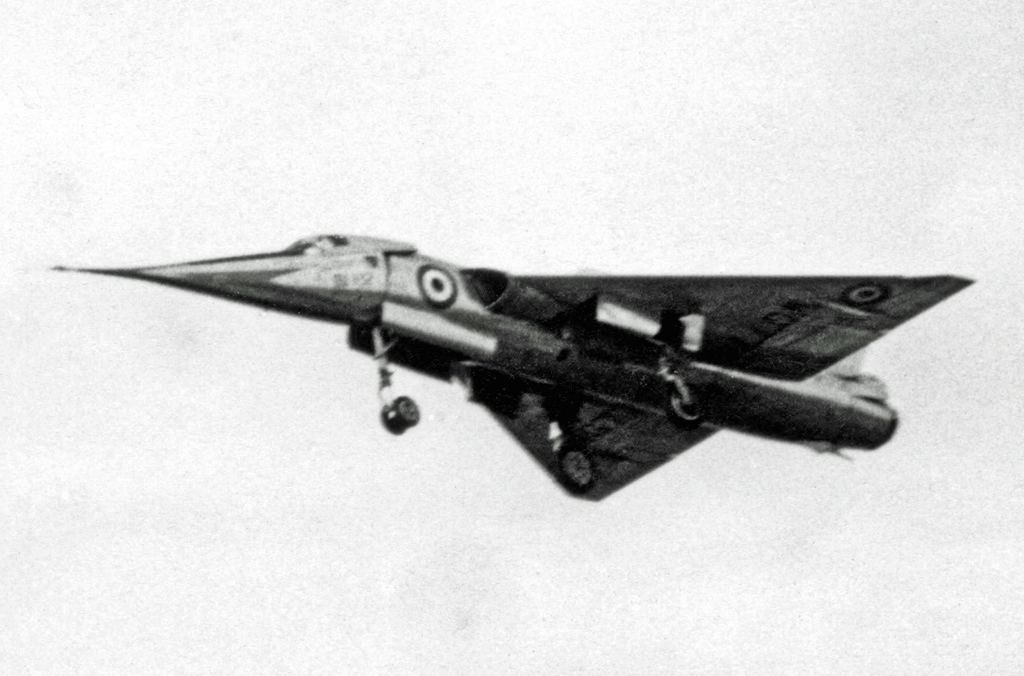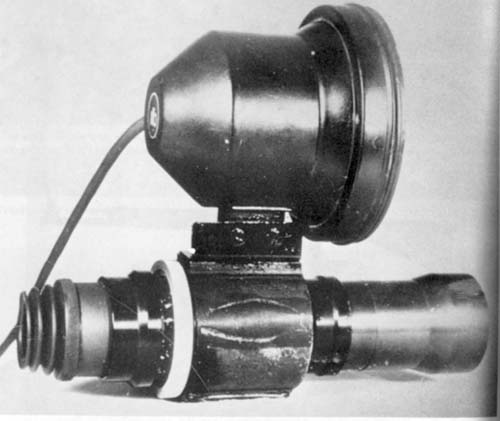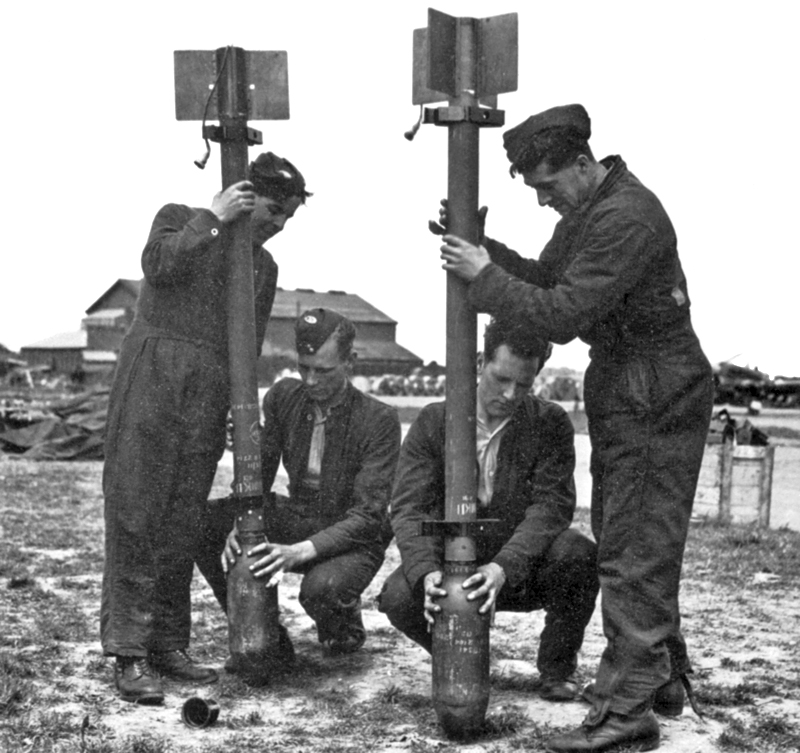|
Fireflash
Fireflash was the United Kingdom's first air-to-air guided missile to see service with the Royal Air Force. Constructed by Fairey Aviation, the missile utilised radar beam riding guidance. Fireflash had relatively limited performance and required the launching aircraft to approach the target from a limited angle astern. The approximately 300 production Fireflash missiles were mostly expended as a training weapon to familiarize RAF pilots with missile firing. It was declared operational very briefly in 1957, thus becoming the RAF's first operational air-to-air missile, but was quickly replaced by the de Havilland Firestreak the next year. Development Red Hawk In January 1945 the Air Ministry issued Operational Requirement OR.1056, given the Ministry of Supply rainbow code "Red Hawk", for an air-to-air missile. The basic design was based on studies carried out at the Royal Aircraft Establishment (RAE) on earlier weapons. Their experiments with the manually-guided Air Spaniel ... [...More Info...] [...Related Items...] OR: [Wikipedia] [Google] [Baidu] |
Fairey Aviation
The Fairey Aviation Company Limited was a British aircraft manufacturer of the first half of the 20th century based in Hayes in Middlesex and Heaton Chapel and RAF Ringway in Cheshire. Notable for the design of a number of important military aircraft, including the Fairey III family, the Swordfish, Firefly, and Gannet, it had a strong presence in the supply of naval aircraft, and also built bombers for the RAF. After World War II the company diversified into mechanical engineering and boat-building. The aircraft manufacturing arm was taken over by Westland Aircraft in 1960. Following a series of mergers and takeovers, the principal successor businesses to the company now trade as FBM Babcock Marine Ltd, Spectris plc, and WFEL (formerly Williams Fairey Engineering Limited), the latter manufacturing portable bridges. History Founded in 1915 by Charles Richard Fairey (later Sir Richard Fairey) and Belgian engineer Ernest Oscar Tips on their departure from Short Brothers, the ... [...More Info...] [...Related Items...] OR: [Wikipedia] [Google] [Baidu] |
Air-to-air Missile
The newest and the oldest member of Rafael's Python family of AAM for comparisons, Python-5 (displayed lower-front) and Shafrir-1 (upper-back) An air-to-air missile (AAM) is a missile fired from an aircraft for the purpose of destroying another aircraft. AAMs are typically powered by one or more rocket motors, usually solid fueled but sometimes liquid fueled. Ramjet engines, as used on the Meteor, are emerging as propulsion that will enable future medium-range missiles to maintain higher average speed across their engagement envelope. Air-to-air missiles are broadly put in two groups. Those designed to engage opposing aircraft at ranges of less than 16 km are known as short-range or "within visual range" missiles (SRAAMs or WVRAAMs) and are sometimes called "dogfight" missiles because they are designed to optimize their agility rather than range. Most use infrared guidance and are called heat-seeking missiles. In contrast, medium- or long-range missiles (MRAAMs or L ... [...More Info...] [...Related Items...] OR: [Wikipedia] [Google] [Baidu] |
Fairey Aviation Company
The Fairey Aviation Company Limited was a British aircraft manufacturer of the first half of the 20th century based in Hayes in Middlesex and Heaton Chapel and RAF Ringway in Cheshire. Notable for the design of a number of important military aircraft, including the Fairey III family, the Swordfish, Firefly, and Gannet, it had a strong presence in the supply of naval aircraft, and also built bombers for the RAF. After World War II the company diversified into mechanical engineering and boat-building. The aircraft manufacturing arm was taken over by Westland Aircraft in 1960. Following a series of mergers and takeovers, the principal successor businesses to the company now trade as FBM Babcock Marine Ltd, Spectris plc, and WFEL (formerly Williams Fairey Engineering Limited), the latter manufacturing portable bridges. History Founded in 1915 by Charles Richard Fairey (later Sir Richard Fairey) and Belgian engineer Ernest Oscar Tips on their departure from Short Brothers, the ... [...More Info...] [...Related Items...] OR: [Wikipedia] [Google] [Baidu] |
De Havilland Firestreak
The de Havilland Firestreak is a British first-generation, passive infrared homing (heat seeking) air-to-air missile. It was developed by de Havilland Propellers (later Hawker Siddeley) in the early 1950s, entering service in 1957. It was the first such weapon to enter active service with the Royal Air Force (RAF) and Fleet Air Arm, equipping the English Electric Lightning, de Havilland Sea Vixen and Gloster Javelin. It was a rear-aspect, fire and forget pursuit weapon, with a field of attack of 20 degrees either side of the target.Gibson 2007, p. 33 Developed under the rainbow code "Blue Jay", Firestreak was the third heat-seeking missile to enter service, after the US AIM-4 Falcon and AIM-9 Sidewinder, both of which entered service the previous year. In comparison to those designs, the Firestreak was larger and almost twice as heavy, carrying a much larger warhead. It had otherwise similar performance in terms of speed and range. It was also a very complex system, with an unusu ... [...More Info...] [...Related Items...] OR: [Wikipedia] [Google] [Baidu] |
Rainbow Code
The Rainbow Codes were a series of code names used to disguise the nature of various British military research projects. They were mainly used by the Ministry of Supply from the end of the Second World War until 1958, when the ministry was broken up and its functions distributed among the forces. The codes were replaced by an alphanumeric code system. History During WWII, British intelligence was able to glean details of new German technologies simply by considering their code names. For instance, when they heard of a new system known as ''Wotan'', Reginald Victor Jones asked around and found that Wotan was a one-eyed god. Based on this, he guessed it was a radio navigation system using a single radio beam. This proved correct, and the Royal Air Force was able to quickly render it useless through jamming. Wishing to avoid making this sort of mistake, Ministry of Supply (MoS) initiated a system that would be entirely random and deliberately unrelated to the program in any way, w ... [...More Info...] [...Related Items...] OR: [Wikipedia] [Google] [Baidu] |
Seaslug (missile)
Seaslug was a first-generation surface-to-air missile designed by Armstrong Whitworth (later part of the Hawker Siddeley group) for use by the Royal Navy. Tracing its history as far back as 1943's LOPGAP design, it came into operational service in 1961 and was still in use at the time of the Falklands War in 1982. Seaslug was intended to engage high-flying targets such as reconnaissance aircraft or bombers before they could launch stand-off weapons. It was only fitted to the Royal Navy's eight County-class destroyers which were designed around the missile system. Seaslug was only fired in anger once as an anti-aircraft missile, from during the Falklands War, but missed its target. Later improvements meant that it could also be used against ships and ground targets. It was planned that Seaslug's medium-range role was to be supplanted by a very long-range missile known as Blue Envoy, but this was passed over in favour of a new medium-range system, Sea Dart. Sea Dart entered service ... [...More Info...] [...Related Items...] OR: [Wikipedia] [Google] [Baidu] |
Fairey Delta 2
The Fairey Delta 2 or FD2 (internal designation Type V within Fairey) is a British supersonic research aircraft that was produced by the Fairey Aviation Company in response to a specification from the Ministry of Supply for a specialised aircraft for conducting investigations into flight and control at transonic and supersonic speeds. Features included a delta wing and a drooped nose. On 6 October 1954, the Delta 2 made its maiden flight, flown by Fairey test pilot Peter Twiss; two aircraft would be produced. The Delta 2 was the final aircraft to be produced by Fairey as an independent manufacturer. The Fairey Delta 2 was the first jet aircraft to exceed in level flight. On 10 March 1956, it set a new world speed record of , exceeding the previous official record by . The Delta 2 held the absolute World Air Speed Record for over a year. It continued to be used for flight testing, and was allocated to the Royal Aircraft Establishment (RAE) in 1958. A testbed aircraft was requi ... [...More Info...] [...Related Items...] OR: [Wikipedia] [Google] [Baidu] |
Cordite
Cordite is a family of smokeless propellants developed and produced in the United Kingdom since 1889 to replace black powder as a military propellant. Like modern gunpowder, cordite is classified as a low explosive because of its slow burning rates and consequently low brisance. These produce a subsonic deflagration wave rather than the supersonic detonation wave produced by brisants, or high explosives. The hot gases produced by burning gunpowder or cordite generate sufficient pressure to propel a bullet or shell to its target, but not so quickly as to routinely destroy the barrel of the gun. Cordite was used initially in the .303 British, Mark I and II, standard rifle cartridge between 1891 and 1915; shortages of cordite in World War I led to the creation of the "Devil's Porridge" munitions factory (HM Factory, Gretna) on the English-Scottish border, which produced 800 tonnes of cordite per annum. The UK also imported some United States–developed smokeless powders for us ... [...More Info...] [...Related Items...] OR: [Wikipedia] [Google] [Baidu] |
Ionize
Ionization, or Ionisation is the process by which an atom or a molecule acquires a negative or positive charge by gaining or losing electrons, often in conjunction with other chemical changes. The resulting electrically charged atom or molecule is called an ion. Ionization can result from the loss of an electron after collisions with subatomic particles, collisions with other atoms, molecules and ions, or through the interaction with electromagnetic radiation. Heterolytic bond cleavage and heterolytic substitution reactions can result in the formation of ion pairs. Ionization can occur through radioactive decay by the internal conversion process, in which an excited nucleus transfers its energy to one of the inner-shell electrons causing it to be ejected. Uses Everyday examples of gas ionization are such as within a fluorescent lamp or other electrical discharge lamps. It is also used in radiation detectors such as the Geiger-Müller counter or the ionization chamber. The ionizati ... [...More Info...] [...Related Items...] OR: [Wikipedia] [Google] [Baidu] |
Infrared Seeking
Infrared homing is a passive weapon guidance system which uses the infrared (IR) light emission from a target to track and follow it seamlessly. Missiles which use infrared seeking are often referred to as "heat-seekers" since infrared is radiated strongly by hot bodies. Many objects such as people, vehicle engines and aircraft generate and emit heat and so are especially visible in the infrared wavelengths of light compared to objects in the background. Infrared seekers are passive devices, which, unlike radar, provide no indication that they are tracking a target. That makes them suitable for sneak attacks during visual encounters or over longer ranges when they are used with a forward looking infrared or similar cuing system. Heat-seekers are extremely effective: 90% of all United States air combat losses over the past 25 years have been caused by infrared-homing missiles. They are, however, subject to a number of simple countermeasures, most notably by dropping flares be ... [...More Info...] [...Related Items...] OR: [Wikipedia] [Google] [Baidu] |
State Of The Art
The state of the art (sometimes cutting edge or leading edge) refers to the highest level of general development, as of a device, technique, or scientific field achieved at a particular time. However, in some contexts it can also refer to a level of development reached at any particular time as a result of the common methodologies employed at the time. The term has been used since 1910, and has become both a common term in advertising and marketing, and a legally significant phrase with respect to both patent law and tort liability. In advertising, the phrase is often used to convey that a product is made with the best or latest available technology, but it has been noted that "the term 'state of the art' requires little proof on the part of advertisers", as it is considered mere puffery. The use of the term in patent law "does not connote even superiority, let alone the superlative quality the ad writers would have us ascribe to the term". Origin and history The origin of th ... [...More Info...] [...Related Items...] OR: [Wikipedia] [Google] [Baidu] |
RP-3
The RP-3 (from Rocket Projectile 3 inch) was a British air to ground rocket projectile introduced during the Second World War. The "3 inch" designation referred to the nominal diameter of the rocket motor tube. The use of a warhead gave rise to the alternative name of the "60-pound rocket". Though primarily an air-to-ground weapon, it saw limited use in other roles. They were generally used by British fighter-bomber aircraft against targets such as tanks, trains, motor transport and buildings, as well as by Coastal Command and Royal Navy aircraft against U-boats and ships. Use continued post-war, with the last known major operational use being during the Aden Emergency in 1964, where Hawker Hunters flew 642 sorties and fired 2,508 RP-3s in support of Radforce. Use continued until the withdrawal from Aden in November 1967, at which point the RP-3 was withdrawn from service in favour of the newer SNEB. Concerned about the possibility of shipboard radar setting off the SNEB's elect ... [...More Info...] [...Related Items...] OR: [Wikipedia] [Google] [Baidu] |


.jpg)






